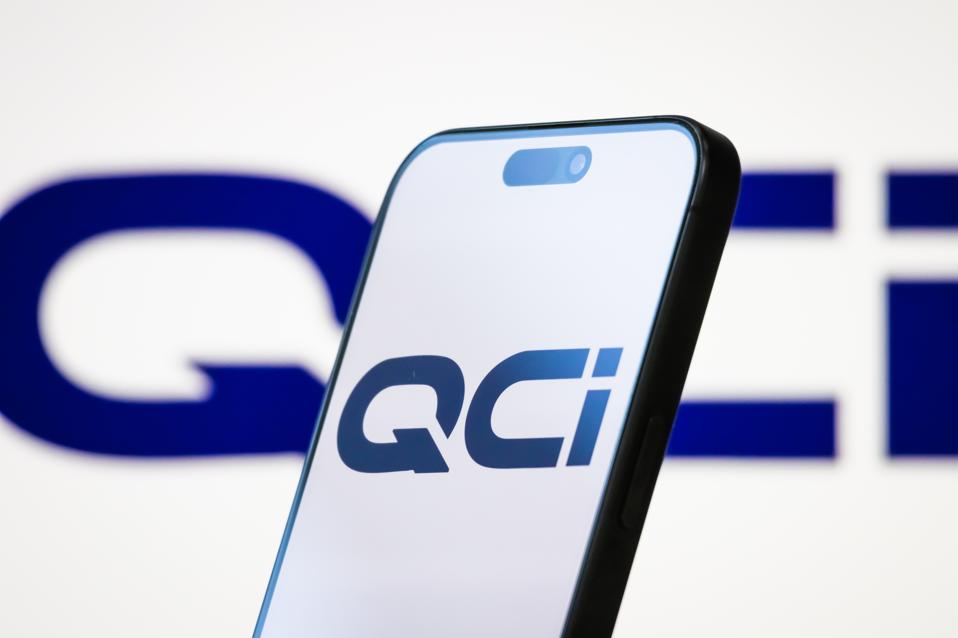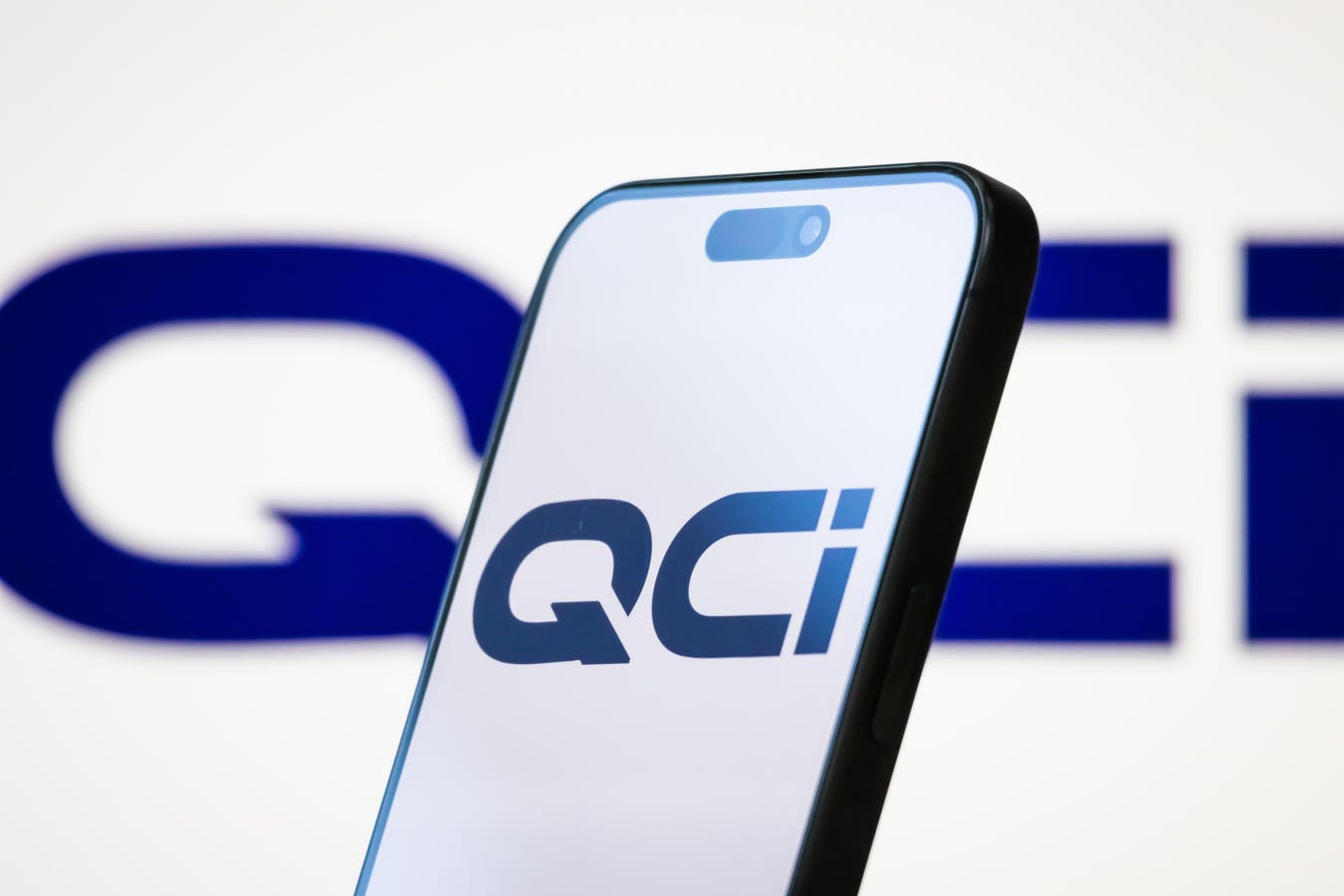
CHONGQING, CHINA – MAY 11: In this photo illustration, the logo of Quantum Computing Inc. (QCi) is displayed on a smartphone screen, with the company’s branding visible in the background, on May 11, 2025, in Chongqing, China. Quantum Computing Inc. is an American technology company specializing in quantum-ready software and advanced quantum computing solutions for real-world business applications. (Photo illustration by Cheng Xin/Getty Images)
Getty Images
Quantum Computing Inc. (NASDAQ: QUBT), which develops quantum-compatible chips and photonic hardware for high-performance computing, AI, and cybersecurity, has surged an astonishing 3,000% over the past twelve months. What’s driving this? It’s been a perfect mix of hype and momentum. First, the broader enthusiasm surrounding quantum computing has captivated Wall Street. Second, the ongoing AI boom has investors grouping quantum names into that narrative, despite their technological differences. Third, Quantum Computing Inc. has made several strategic announcements and partnerships that have kept the excitement alive.
The company has been carving out its niche in the quantum technology space, unveiling collaborations and projects that look impressive on paper. However, here’s the reality—quantum computing is indeed the future, but a future still years away from commercial viability. The company’s revenue remains negligible at just $263,000. Unsurprisingly, it’s burning through cash—with a net income margin of -29,054% and an operating cash flow margin of -7,180%.
That said, if you want upside potential with less volatility than owning an individual stock like QUBT, consider the High Quality Portfolio. It has comfortably beaten its benchmark—a mix of the S&P 500, Russell, and S&P MidCap indexes—delivering over 91% cumulative returns since inception. Why? Because HQ Portfolio stocks as a group have offered stronger returns with lower risk compared to the benchmark, avoiding large drawdowns, as shown in HQ Portfolio performance metrics. Also see – Up 500%, What’s Happening With AVGO Stock?
The Fundamental Problem
We agree—quantum stocks are all about long-term potential—and we’ve written about the upside potential for stocks like RGTI ourselves. But have you considered the downside risks? Logically, there are numerous factors that could derail Quantum Computing Inc.’s growth story, and when sentiment turns, speculative stocks don’t just dip—they collapse. That’s not speculation; it’s history.
Historical Precedent: QUBT’s Track Record of Collapse
Consider what happened to QUBT during past market downturns. During the 2022 inflation shock when the Fed rapidly raised interest rates, QUBT’s stock plummeted 93% from $9.62 to $0.67. Even in the 2020 Covid-19 crash, it fell 73% from $5.97 to $1.62. These weren’t mild corrections—they were near-total wipeouts. That’s the stark difference between speculative plays and companies with real, recurring cash flows.
Risk Factors That Could Crush QUBTCommercial Reality Gap: Despite the flashy announcements, Quantum Computing Inc.’s technology remains largely in development. The gap between “promising tech” and “profitable enterprise” is vast, especially given its $263,000 revenue base.Rising Competition: Tech giants such as IBM, Google, Microsoft, and Amazon are investing heavily in quantum computing. Their vast resources allow them to outspend and outlast smaller players in this capital-intensive race.Cash Burn Reality: With margins like -29,054% on net income and -7,180% on operating cash flow, QUBT is essentially a cash furnace betting on a distant technological future. See how Quantum Computing Inc.’s financials compare with other tech firms.Dilution Risk: The company recently announced a $750 million equity placement. This massive issuance will significantly dilute existing shareholders. With its current cash burn, further dilution appears inevitable, leading to a downward spiral in shareholder value.Sentiment Shifts: When risk appetite fades, momentum-driven stocks like QUBT are the first to suffer. Its history demonstrates this clearly.The Real Downside Risk
So, what’s the true downside risk for QUBT from current levels?
If history repeats, the stock could fall 70–93%, dropping to a range between $2 and $7.
Are you prepared for that?
This isn’t fearmongering—it’s what actually occurred in both 2020 and 2022. The fundamentals remain largely unchanged: persistent cash burn, limited commercialization progress, ongoing dilution, and valuation driven mostly by hype rather than results.
If that level of volatility is unsettling, consider the Trefis Reinforced Value (RV) Portfolio, which has consistently outperformed its all-cap benchmark (a blend of the S&P 500, S&P MidCap, and Russell 2000 indices). Its quarterly rebalanced approach across large-, mid-, and small-cap names offers participation in rallies while providing downside protection, as detailed in RV Portfolio performance metrics.
The Bottom Line
This analysis aims to make investors aware of the genuine downside risks associated with QUBT stock. The company’s financials are among the weakest in the public market—a revenue base below $300,000, negative margins over -29,000%, and a recent $750 million equity raise that heavily dilutes shareholders. When market sentiment turns, QUBT’s history shows it can fall hard–and fast.
Investors here aren’t buying a profitable enterprise but are betting that quantum computing becomes commercially viable soon enough for QUBT to survive its cash burn, effectively deploy $750 million in new funds, and compete against tech giants with deeper pockets. The real question is whether you can handle the potential volatility if that optimistic scenario doesn’t unfold as planned.

